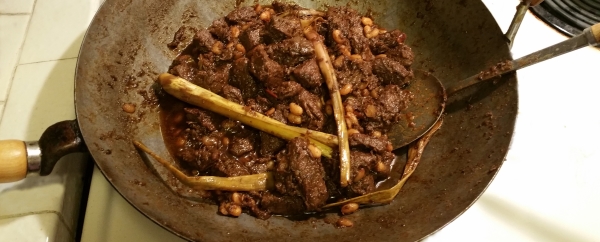
I had the immense pleasure to do my anthropological doctoral research in West Sumatra where I lived in a small (but important) farming community for several years. Typically rendang is made with water buffalo meat, but beef is also widely used. Some non-Minankabau cooks have made it with chicken, although we never encountered this variation in Sumatra. The cooking process turns the white coconut cream into an oily, but relatively dry dish. Cooking the dish for a much shorter period of time creates another fine, but more liquid dish known as kalio, which has a distinctly different (and milder) taste. In West Sumatra, rendang is more commonly cooked without beans, but some cooks there do add small white beans, and we think it's a nice touch. Many recipes call for the use of rehydrated red chilies to add spiciness, but it is more authentic and easier to use sambal olek, which now can be found in most grocery stores here in San Diego. Most rendang is very mild; other versions are spicier but chilies should not be the primary taste you experience. We like it spicier than what is typical, but overdoing the "sambal" will mask the other great flavors.
About the ingredients:
The Minangkabau are devout Muslims but also hold the distinction of being the largest matrilineal society in the world. In matrilineal cultures, family groups (lineages) are comprised of men and women who are exclusively related to each other through females. Matrilineal is not to be confused with matriarchy (rule by women), but Minangkabau women have great informal power in Minangkabau culture. Many important decisions require consensus from all adult members of the lineages. While formal positions of power are overwhelmingly male, such leaders cannot make decisions without full consent from the senior women of the matrilineal. Even though the Minangkabau language does not mark gender (which is true of several languages), gender role differentiation exists. What is different in Minangkabau society is the high value placed on women's roles; they are generally not seen as subservient to male roles or prerogatives. The fact that the Minangkabau are devoutly Muslim and have a matrilineal family system that contributes to female autonomy and power is more of a mystery to outsiders than it is to the Minangkabau themselves. Rendang plays an important role in ceremonial foods and can be bought at nearly all Nasi Padang restaurants. Water buffalo (kabau) and beef (sapi) are relatively expensive in West Sumatra, so it is considered a special food that is not generally eaten as everyday food.
Ingredients:
Main Ingredients:
- 1 1/2 pounds boneless beef short ribs (cut into cubes)
- 1/2 cup of white beans
- 2 tablespoons coconut oil
- 2 cups coconut cream
- 1 stalk of lemongrass, either pounded or deeply scored with a knife
- 2 tablespoons of tamarind sauce
- 6 kaffir lime leaves
- Salt to taste
Spice Paste:
- 5 shallots
- 1 inch piece of galangal
- 1 teaspoon of salt
- 1 tablespoon palm sugar
- 1 teaspoon of turmeric powder
- 1/2 teaspoon cinnamon
- 5 cloves garlic
- 1 inch piece of ginger
- 2 - 5 Tablespoons of Sambal Olek
Preparation:
- Soak the dried white beans in water over night.
- Chop the spices and blend them in a food processor until smooth.
- Heat the coconut oil in a large wok, add the spice paste and fry until aromatic.
- Add Coconut cream, beef, lemongrass, tamarind sauce, and kaffir lime leaves and bring to boil.
- Turn heat down to a simmer.
- Simmer the rendang stirring frequently for 3/4 hour.
- Test the sauce for sweetness and saltiness but remember that by the time the dish finishes cooking the flavors will intensify (so don't overdo the sugar or salt).
- Add the hydrated white beans and continue to cook and stir until the Rendang becomes dark brown and oily.
Serving:
Serve with white Jasmine rice. The rice must be somewhat sticky. The traditional way to eat rendang is with your fingers. Serve the rendang and rice side by side on a plate. For each individual bite, mix some rice with some of the rendang with your fingers and then bring your fingers to your mouth. It takes a tiny bit of practice, the mouthful of rice and rendang is held with the ends of your index, middle, ring fingers and your thumb. After bringing the food to you mouth, use your thumb to push the food into your mouth. It takes a bit of practice but once you figure it out your enjoyment of rendang will be heightened considerably. Green beans, or Chinese long green beans (which is what they have in Sumatra) go well with rendang. Like many dishes, rendang tastes even better a day later and keeps very well. It is one of the dishes that Minangkabau take along when they are traveling as it keeps well even without refrigeration.
Recipe by T. Johnston-O'Neill
Photos by S. Johnston-O'Neill








